G phrygian chords
The Solution below shows the G phrygian mode triad chords (i, II, III, iv, vo, VI, vii) on a piano, with mp3 and midi audio.
The Lesson steps then explain the triad chord construction from this mode, and how to name the quality of each chord based on note intervals.
For a quick summary of this topic, and to see the chord quality chart for this mode, have a look at Mode chord.
| Key | C | C# | Db | D | D# | Eb | E | E# | Fb | F | F# | Gb | [G] | G# | Ab | A | A# | Bb | B | B# | Cb |
|---|
Solution - 7 parts
1. G phrygian chord i
Chord identification
The G phrygian chord i is the G minor chord, and contains the notes G, Bb, and D.
This tonic chord's root / starting note is the 1st note (or scale degree) of the G phrygian mode.
The roman numeral for number 1 is 'i' and is used to indicate this is the 1st triad chord in the mode. It is in lower case to denote that the chord is a minor chord.
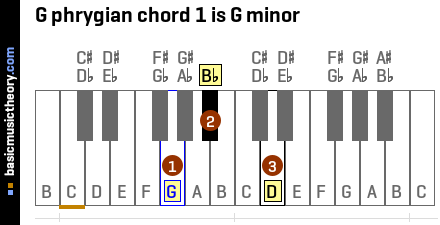
| Chord position | Link | a/b/c notation | Figured bass notation |
|---|---|---|---|
| Root position | G minor chord in root position | ia | |
| 1st inversion | G minor chord in 1st inversion | ib | i6 |
| 2nd inversion | G minor chord in 2nd inversion | ic | i64 |
| Bass Clef: | Midi | MP3 | Treble Clef: | Midi | MP3 |
2. G phrygian chord II
Chord identification
The G phrygian chord II is the Ab major chord, and contains the notes Ab, C, and Eb.
This supertonic chord's root / starting note is the 2nd note (or scale degree) of the G phrygian mode.
The roman numeral for number 2 is 'II' and is used to indicate this is the 2nd triad chord in the mode. It is in upper case to denote that the chord is a major chord.
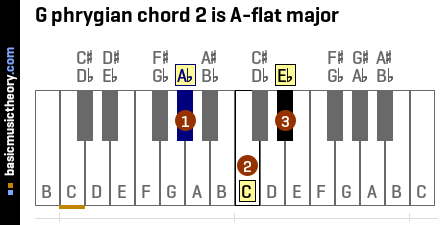
| Chord position | Link | a/b/c notation | Figured bass notation |
|---|---|---|---|
| Root position | Ab major chord in root position | IIa | |
| 1st inversion | Ab major chord in 1st inversion | IIb | II6 |
| 2nd inversion | Ab major chord in 2nd inversion | IIc | II64 |
| Bass Clef: | Midi | MP3 | Treble Clef: | Midi | MP3 |
3. G phrygian chord III
Chord identification
The G phrygian chord III is the Bb major chord, and contains the notes Bb, D, and F.
This mediant chord's root / starting note is the 3rd note (or scale degree) of the G phrygian mode.
The roman numeral for number 3 is 'III' and is used to indicate this is the 3rd triad chord in the mode. It is in upper case to denote that the chord is a major chord.
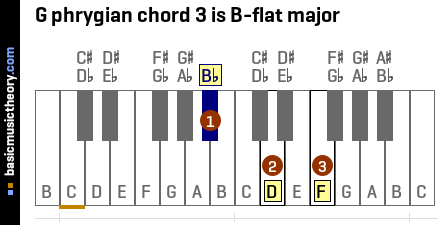
| Chord position | Link | a/b/c notation | Figured bass notation |
|---|---|---|---|
| Root position | Bb major chord in root position | IIIa | |
| 1st inversion | Bb major chord in 1st inversion | IIIb | III6 |
| 2nd inversion | Bb major chord in 2nd inversion | IIIc | III64 |
| Bass Clef: | Midi | MP3 | Treble Clef: | Midi | MP3 |
4. G phrygian chord iv
Chord identification
The G phrygian chord iv is the C minor chord, and contains the notes C, Eb, and G.
This subdominant chord's root / starting note is the 4th note (or scale degree) of the G phrygian mode.
The roman numeral for number 4 is 'iv' and is used to indicate this is the 4th triad chord in the mode. It is in lower case to denote that the chord is a minor chord.
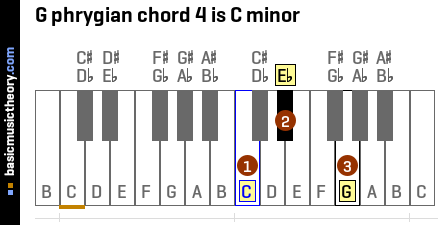
| Chord position | Link | a/b/c notation | Figured bass notation |
|---|---|---|---|
| Root position | C minor chord in root position | iva | |
| 1st inversion | C minor chord in 1st inversion | ivb | iv6 |
| 2nd inversion | C minor chord in 2nd inversion | ivc | iv64 |
| Bass Clef: | Midi | MP3 | Treble Clef: | Midi | MP3 |
5. G phrygian chord vo
Chord identification
The G phrygian chord vo is the D diminished chord, and contains the notes D, F, and Ab.
This dominant chord's root / starting note is the 5th note (or scale degree) of the G phrygian mode.
The roman numeral for number 5 is 'v' and is used to indicate this is the 5th triad chord in the mode. Just like a minor chord, the diminished chord is constructed using a minor third interval, so the roman numeral is shown in lower case.
The diminished symbol 'o' is placed after the roman numerals to indicate this is a diminished chord.
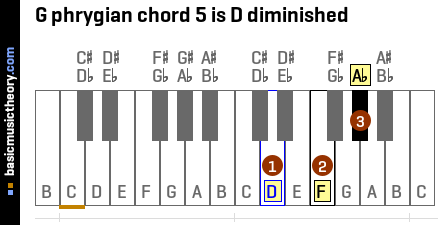
| Chord position | Link | a/b/c notation | Figured bass notation |
|---|---|---|---|
| Root position | D diminished chord in root position | voa | |
| 1st inversion | D diminished chord in 1st inversion | vob | vo6 |
| 2nd inversion | D diminished chord in 2nd inversion | voc | vo64 |
| Bass Clef: | Midi | MP3 | Treble Clef: | Midi | MP3 |
6. G phrygian chord VI
Chord identification
The G phrygian chord VI is the Eb major chord, and contains the notes Eb, G, and Bb.
This submediant chord's root / starting note is the 6th note (or scale degree) of the G phrygian mode.
The roman numeral for number 6 is 'VI' and is used to indicate this is the 6th triad chord in the mode. It is in upper case to denote that the chord is a major chord.
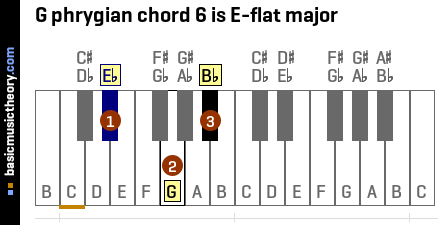
| Chord position | Link | a/b/c notation | Figured bass notation |
|---|---|---|---|
| Root position | Eb major chord in root position | VIa | |
| 1st inversion | Eb major chord in 1st inversion | VIb | VI6 |
| 2nd inversion | Eb major chord in 2nd inversion | VIc | VI64 |
| Bass Clef: | Midi | MP3 | Treble Clef: | Midi | MP3 |
7. G phrygian chord vii
Chord identification
The G phrygian chord vii is the F minor chord, and contains the notes F, Ab, and C.
This subtonic chord's root / starting note is the 7th note (or scale degree) of the G phrygian mode.
The roman numeral for number 7 is 'vii' and is used to indicate this is the 7th triad chord in the mode. It is in lower case to denote that the chord is a minor chord.
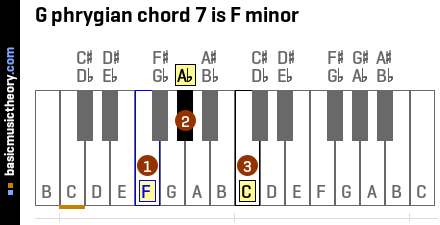
| Chord position | Link | a/b/c notation | Figured bass notation |
|---|---|---|---|
| Root position | F minor chord in root position | viia | |
| 1st inversion | F minor chord in 1st inversion | viib | vii6 |
| 2nd inversion | F minor chord in 2nd inversion | viic | vii64 |
| Bass Clef: | Midi | MP3 | Treble Clef: | Midi | MP3 |
Lesson steps
1. Piano key note names
The white keys are named using the alphabetic letters A, B, C, D, E, F, and G, which is a pattern that repeats up the piano keyboard.
Every white or black key could have a flat(b) or sharp(#) accidental name, depending on how that note is used. In a later step, if sharp or flat notes are used, the exact accidental names will be chosen.
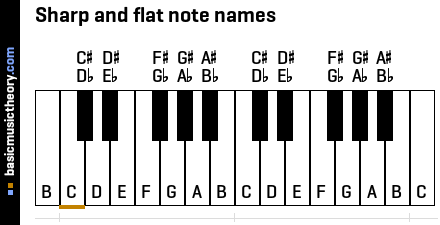
The audio files below play every note shown on the piano above, so middle C (marked with an orange line at the bottom) is the 2nd note heard.
| Bass Clef: | Midi | MP3 | Treble Clef: | Midi | MP3 |
2. G phrygian mode notes
The piano keyboard below contains the notes of the G phrygian mode.
Starting from the 1st mode note, each lesson step below will take each note in turn and construct a triad chord using that note as the root / starting note of that chord.
The triad chord will be built using only the notes of the mode we are interested in.
Identifying the 3 notes in the chord
Triad chords are built using the 1st, 3rdand 5th notes of the mode, so the first triad below will constructed a chord using notes G, Bb and D.
| No. | 1 | 2 | 3 | 4 | 5 | 6 | 7 | 8 |
|---|---|---|---|---|---|---|---|---|
| Note | G | Ab | Bb | C | D | Eb | F | G |
The second triad below will repeat this, but this time starting on the 2nd note, so its notes will be Ab, C and Eb - ie. the 1st, 3rd and 5th positions relative to that 2nd root note.
This pattern is repeated for all 7 notes in the mode, resulting in 7 triad chords.
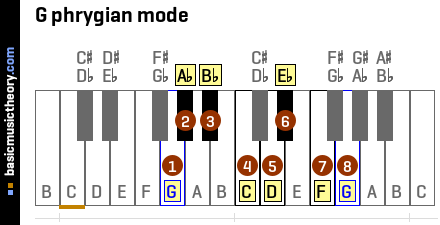
Identifying the chord quality
Although the above method identifies each triads notes from the mode used - it does not identify the complete chord name including its quality.
Should each triad that we build be called major, minor, augmented, or diminished ? Every triad chord must have one of these quality names.
To decide the name the chord quality, each step below will use note intervals to calculate how many half-tones / semitones / piano keys between the root and the 3rd (and 5th).
Taken together, the combination of the 3rd and 5th note intervals will define the complete triad quality name.
The steps below will show how this works for each triad in turn, but in practice it might just be easier to memorize the triad quality table in the Mode chord summary for each mode type.
| Bass Clef: | Midi | MP3 | Treble Clef: | Midi | MP3 |
3. 1st triad chord in G phrygian mode
Identifying the 3 notes in the chord
The table below shows the G phrygian mode, ordered to show the 1st note as the first column in the table.
To identify the triad chord note names, use the 1st, 3rd, and 5th columns / scale degrees, which are notes G, Bb, and D.
| No. | 1 | 2 | 3 | 4 | 5 | 6 | 7 |
|---|---|---|---|---|---|---|---|
| Note | G | Ab | Bb | C | D | Eb | F |
Identifying the chord quality
To identify the triad chord quality that has these notes, begin by counting the number of half-tones / semitones between the root and each of the notes.
For the 3rd Interval (note 2 on the diagram) the distance between G and Bb is 3 half-tones.
Now look at the complete Note interval table, and identify the note interval that has a distance of 3 half-tones (first column), and with an interval no. of 3 (last column).
The note interval name for the 3rd note / scale degree is therefore minor, also called m3 for short. More details of this interval are at G-min-3rd.
Repeating this for the 5th note / scale degree, the distance between G and D is 7 half-tones, and the note interval name is perfect (P5). More details of this interval are at G-perf-5th.
Finally, we have the name of the two note intervals of this triad, and can now lookup the name of the triad chord quality having these intervals.
Looking at the Triad chord table, the name of the triad chord quality having minor(m3) and perfect(P5) note intervals is minor.
And so the complete triad chord name prefixes the root note, G, onto this quality, giving us the G minor chord.
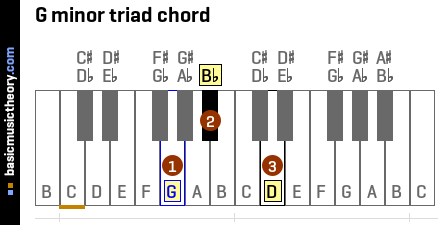
Scale chord names using a,b and c notation
The chord symbol i could be followed by the letter a to indicate that it is G minor chord in root position (ie not inverted) - G phrygian mode chord ia.
Instead, i could be followed by the letter b to indicate that it is G minor chord in 1st inversion - G phrygian mode chord ib.
Finally, letter c could be used to indicate that it is G minor chord in 2nd inversion - G phrygian mode chord ic.
Scale chord names using figured bass notation
In place of the b or c symbols above, figured bass symbols could be used to indicate inversions after the chord number symbols i:
So in this key, i6 refers to the G minor chord in 1st inversion, and i64 refers to the G minor chord in 2nd inversion.
The next scale chord
The next step will need to calculate the triad chord whose root / starting note is next mode note.
To do this, the first column we used in this step, G, will be moved to the final column of the table.
| Bass Clef: | Midi | MP3 | Treble Clef: | Midi | MP3 |
4. 2nd triad chord in G phrygian mode
Identifying the 3 notes in the chord
The table below shows the G phrygian mode, ordered to show the 2nd note as the first column in the table.
To identify the triad chord note names, use the 1st, 3rd, and 5th columns / scale degrees, which are notes Ab, C, and Eb.
| No. | 1 | 2 | 3 | 4 | 5 | 6 | 7 |
|---|---|---|---|---|---|---|---|
| Note | Ab | Bb | C | D | Eb | F | G |
Identifying the chord quality
To identify the triad chord quality that has these notes, begin by counting the number of half-tones / semitones between the root and each of the notes.
For the 3rd Interval (note 2 on the diagram) the distance between Ab and C is 4 half-tones.
Now look at the complete Note interval table, and identify the note interval that has a distance of 3 half-tones (first column), and with an interval no. of 3 (last column).
The note interval name for the 3rd note / scale degree is therefore major, also called M3 for short. More details of this interval are at Ab-maj-3rd.
Repeating this for the 5th note / scale degree, the distance between Ab and Eb is 7 half-tones, and the note interval name is perfect (P5). More details of this interval are at Ab-perf-5th.
Finally, we have the name of the two note intervals of this triad, and can now lookup the name of the triad chord quality having these intervals.
Looking at the Triad chord table, the name of the triad chord quality having major(M3) and perfect(P5) note intervals is major.
And so the complete triad chord name prefixes the root note, Ab, onto this quality, giving us the Ab major chord.
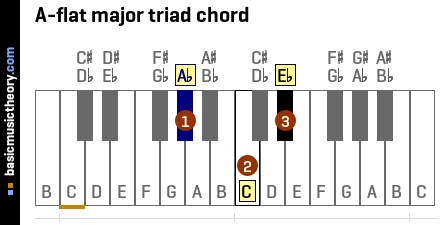
Scale chord names using a,b and c notation
The chord symbol II could be followed by the letter a to indicate that it is Ab major chord in root position (ie not inverted) - G phrygian mode chord IIa.
Instead, II could be followed by the letter b to indicate that it is Ab major chord in 1st inversion - G phrygian mode chord IIb.
Finally, letter c could be used to indicate that it is Ab major chord in 2nd inversion - G phrygian mode chord IIc.
Scale chord names using figured bass notation
In place of the b or c symbols above, figured bass symbols could be used to indicate inversions after the chord number symbols II:
So in this key, II6 refers to the Ab major chord in 1st inversion, and II64 refers to the Ab major chord in 2nd inversion.
The next scale chord
The next step will need to calculate the triad chord whose root / starting note is next mode note.
To do this, the first column we used in this step, Ab, will be moved to the final column of the table.
| Bass Clef: | Midi | MP3 | Treble Clef: | Midi | MP3 |
5. 3rd triad chord in G phrygian mode
Identifying the 3 notes in the chord
The table below shows the G phrygian mode, ordered to show the 3rd note as the first column in the table.
To identify the triad chord note names, use the 1st, 3rd, and 5th columns / scale degrees, which are notes Bb, D, and F.
| No. | 1 | 2 | 3 | 4 | 5 | 6 | 7 |
|---|---|---|---|---|---|---|---|
| Note | Bb | C | D | Eb | F | G | Ab |
Identifying the chord quality
To identify the triad chord quality that has these notes, begin by counting the number of half-tones / semitones between the root and each of the notes.
For the 3rd Interval (note 2 on the diagram) the distance between Bb and D is 4 half-tones.
Now look at the complete Note interval table, and identify the note interval that has a distance of 3 half-tones (first column), and with an interval no. of 3 (last column).
The note interval name for the 3rd note / scale degree is therefore major, also called M3 for short. More details of this interval are at Bb-maj-3rd.
Repeating this for the 5th note / scale degree, the distance between Bb and F is 7 half-tones, and the note interval name is perfect (P5). More details of this interval are at Bb-perf-5th.
Finally, we have the name of the two note intervals of this triad, and can now lookup the name of the triad chord quality having these intervals.
Looking at the Triad chord table, the name of the triad chord quality having major(M3) and perfect(P5) note intervals is major.
And so the complete triad chord name prefixes the root note, Bb, onto this quality, giving us the Bb major chord.
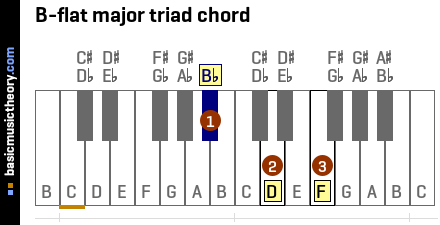
Scale chord names using a,b and c notation
The chord symbol III could be followed by the letter a to indicate that it is Bb major chord in root position (ie not inverted) - G phrygian mode chord IIIa.
Instead, III could be followed by the letter b to indicate that it is Bb major chord in 1st inversion - G phrygian mode chord IIIb.
Finally, letter c could be used to indicate that it is Bb major chord in 2nd inversion - G phrygian mode chord IIIc.
Scale chord names using figured bass notation
In place of the b or c symbols above, figured bass symbols could be used to indicate inversions after the chord number symbols III:
So in this key, III6 refers to the Bb major chord in 1st inversion, and III64 refers to the Bb major chord in 2nd inversion.
The next scale chord
The next step will need to calculate the triad chord whose root / starting note is next mode note.
To do this, the first column we used in this step, Bb, will be moved to the final column of the table.
| Bass Clef: | Midi | MP3 | Treble Clef: | Midi | MP3 |
6. 4th triad chord in G phrygian mode
Identifying the 3 notes in the chord
The table below shows the G phrygian mode, ordered to show the 4th note as the first column in the table.
To identify the triad chord note names, use the 1st, 3rd, and 5th columns / scale degrees, which are notes C, Eb, and G.
| No. | 1 | 2 | 3 | 4 | 5 | 6 | 7 |
|---|---|---|---|---|---|---|---|
| Note | C | D | Eb | F | G | Ab | Bb |
Identifying the chord quality
To identify the triad chord quality that has these notes, begin by counting the number of half-tones / semitones between the root and each of the notes.
For the 3rd Interval (note 2 on the diagram) the distance between C and Eb is 3 half-tones.
Now look at the complete Note interval table, and identify the note interval that has a distance of 3 half-tones (first column), and with an interval no. of 3 (last column).
The note interval name for the 3rd note / scale degree is therefore minor, also called m3 for short. More details of this interval are at C-min-3rd.
Repeating this for the 5th note / scale degree, the distance between C and G is 7 half-tones, and the note interval name is perfect (P5). More details of this interval are at C-perf-5th.
Finally, we have the name of the two note intervals of this triad, and can now lookup the name of the triad chord quality having these intervals.
Looking at the Triad chord table, the name of the triad chord quality having minor(m3) and perfect(P5) note intervals is minor.
And so the complete triad chord name prefixes the root note, C, onto this quality, giving us the C minor chord.
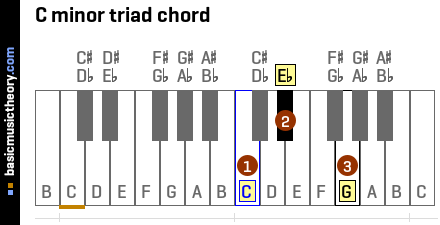
Scale chord names using a,b and c notation
The chord symbol iv could be followed by the letter a to indicate that it is C minor chord in root position (ie not inverted) - G phrygian mode chord iva.
Instead, iv could be followed by the letter b to indicate that it is C minor chord in 1st inversion - G phrygian mode chord ivb.
Finally, letter c could be used to indicate that it is C minor chord in 2nd inversion - G phrygian mode chord ivc.
Scale chord names using figured bass notation
In place of the b or c symbols above, figured bass symbols could be used to indicate inversions after the chord number symbols iv:
So in this key, iv6 refers to the C minor chord in 1st inversion, and iv64 refers to the C minor chord in 2nd inversion.
The next scale chord
The next step will need to calculate the triad chord whose root / starting note is next mode note.
To do this, the first column we used in this step, C, will be moved to the final column of the table.
| Bass Clef: | Midi | MP3 | Treble Clef: | Midi | MP3 |
7. 5th triad chord in G phrygian mode
Identifying the 3 notes in the chord
The table below shows the G phrygian mode, ordered to show the 5th note as the first column in the table.
To identify the triad chord note names, use the 1st, 3rd, and 5th columns / scale degrees, which are notes D, F, and Ab.
| No. | 1 | 2 | 3 | 4 | 5 | 6 | 7 |
|---|---|---|---|---|---|---|---|
| Note | D | Eb | F | G | Ab | Bb | C |
Identifying the chord quality
To identify the triad chord quality that has these notes, begin by counting the number of half-tones / semitones between the root and each of the notes.
For the 3rd Interval (note 2 on the diagram) the distance between D and F is 3 half-tones.
Now look at the complete Note interval table, and identify the note interval that has a distance of 3 half-tones (first column), and with an interval no. of 3 (last column).
The note interval name for the 3rd note / scale degree is therefore minor, also called m3 for short. More details of this interval are at D-min-3rd.
Repeating this for the 5th note / scale degree, the distance between D and Ab is 6 half-tones, and the note interval name is diminished (d5). More details of this interval are at D-dim-5th.
Finally, we have the name of the two note intervals of this triad, and can now lookup the name of the triad chord quality having these intervals.
Looking at the Triad chord table, the name of the triad chord quality having minor(m3) and diminished(d5) note intervals is diminished.
And so the complete triad chord name prefixes the root note, D, onto this quality, giving us the D diminished chord.
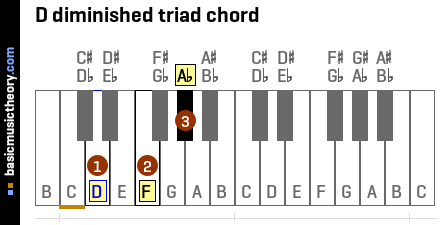
Scale chord names using a,b and c notation
The chord symbol vo could be followed by the letter a to indicate that it is D diminished chord in root position (ie not inverted) - G phrygian mode chord voa.
Instead, vo could be followed by the letter b to indicate that it is D diminished chord in 1st inversion - G phrygian mode chord vob.
Finally, letter c could be used to indicate that it is D diminished chord in 2nd inversion - G phrygian mode chord voc.
Scale chord names using figured bass notation
In place of the b or c symbols above, figured bass symbols could be used to indicate inversions after the chord number symbols vo:
So in this key, vo6 refers to the D diminished chord in 1st inversion, and vo64 refers to the D diminished chord in 2nd inversion.
The next scale chord
The next step will need to calculate the triad chord whose root / starting note is next mode note.
To do this, the first column we used in this step, D, will be moved to the final column of the table.
| Bass Clef: | Midi | MP3 | Treble Clef: | Midi | MP3 |
8. 6th triad chord in G phrygian mode
Identifying the 3 notes in the chord
The table below shows the G phrygian mode, ordered to show the 6th note as the first column in the table.
To identify the triad chord note names, use the 1st, 3rd, and 5th columns / scale degrees, which are notes Eb, G, and Bb.
| No. | 1 | 2 | 3 | 4 | 5 | 6 | 7 |
|---|---|---|---|---|---|---|---|
| Note | Eb | F | G | Ab | Bb | C | D |
Identifying the chord quality
To identify the triad chord quality that has these notes, begin by counting the number of half-tones / semitones between the root and each of the notes.
For the 3rd Interval (note 2 on the diagram) the distance between Eb and G is 4 half-tones.
Now look at the complete Note interval table, and identify the note interval that has a distance of 3 half-tones (first column), and with an interval no. of 3 (last column).
The note interval name for the 3rd note / scale degree is therefore major, also called M3 for short. More details of this interval are at Eb-maj-3rd.
Repeating this for the 5th note / scale degree, the distance between Eb and Bb is 7 half-tones, and the note interval name is perfect (P5). More details of this interval are at Eb-perf-5th.
Finally, we have the name of the two note intervals of this triad, and can now lookup the name of the triad chord quality having these intervals.
Looking at the Triad chord table, the name of the triad chord quality having major(M3) and perfect(P5) note intervals is major.
And so the complete triad chord name prefixes the root note, Eb, onto this quality, giving us the Eb major chord.
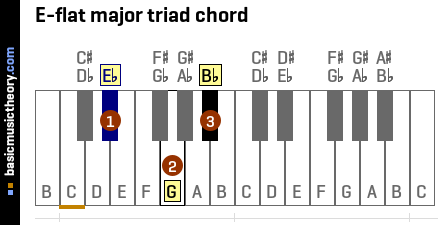
Scale chord names using a,b and c notation
The chord symbol VI could be followed by the letter a to indicate that it is Eb major chord in root position (ie not inverted) - G phrygian mode chord VIa.
Instead, VI could be followed by the letter b to indicate that it is Eb major chord in 1st inversion - G phrygian mode chord VIb.
Finally, letter c could be used to indicate that it is Eb major chord in 2nd inversion - G phrygian mode chord VIc.
Scale chord names using figured bass notation
In place of the b or c symbols above, figured bass symbols could be used to indicate inversions after the chord number symbols VI:
So in this key, VI6 refers to the Eb major chord in 1st inversion, and VI64 refers to the Eb major chord in 2nd inversion.
The next scale chord
The next step will need to calculate the triad chord whose root / starting note is next mode note.
To do this, the first column we used in this step, Eb, will be moved to the final column of the table.
| Bass Clef: | Midi | MP3 | Treble Clef: | Midi | MP3 |
9. 7th triad chord in G phrygian mode
Identifying the 3 notes in the chord
The table below shows the G phrygian mode, ordered to show the 7th note as the first column in the table.
To identify the triad chord note names, use the 1st, 3rd, and 5th columns / scale degrees, which are notes F, Ab, and C.
| No. | 1 | 2 | 3 | 4 | 5 | 6 | 7 |
|---|---|---|---|---|---|---|---|
| Note | F | G | Ab | Bb | C | D | Eb |
Identifying the chord quality
To identify the triad chord quality that has these notes, begin by counting the number of half-tones / semitones between the root and each of the notes.
For the 3rd Interval (note 2 on the diagram) the distance between F and Ab is 3 half-tones.
Now look at the complete Note interval table, and identify the note interval that has a distance of 3 half-tones (first column), and with an interval no. of 3 (last column).
The note interval name for the 3rd note / scale degree is therefore minor, also called m3 for short. More details of this interval are at F-min-3rd.
Repeating this for the 5th note / scale degree, the distance between F and C is 7 half-tones, and the note interval name is perfect (P5). More details of this interval are at F-perf-5th.
Finally, we have the name of the two note intervals of this triad, and can now lookup the name of the triad chord quality having these intervals.
Looking at the Triad chord table, the name of the triad chord quality having minor(m3) and perfect(P5) note intervals is minor.
And so the complete triad chord name prefixes the root note, F, onto this quality, giving us the F minor chord.
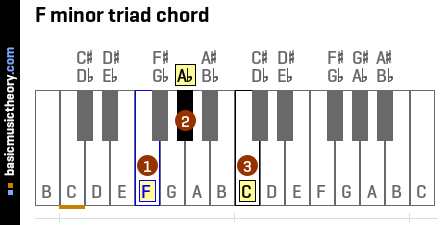
Scale chord names using a,b and c notation
The chord symbol vii could be followed by the letter a to indicate that it is F minor chord in root position (ie not inverted) - G phrygian mode chord viia.
Instead, vii could be followed by the letter b to indicate that it is F minor chord in 1st inversion - G phrygian mode chord viib.
Finally, letter c could be used to indicate that it is F minor chord in 2nd inversion - G phrygian mode chord viic.
Scale chord names using figured bass notation
In place of the b or c symbols above, figured bass symbols could be used to indicate inversions after the chord number symbols vii:
So in this key, vii6 refers to the F minor chord in 1st inversion, and vii64 refers to the F minor chord in 2nd inversion.
This completes the set of all triad chords that harmonize with the G phrygian mode.
| Bass Clef: | Midi | MP3 | Treble Clef: | Midi | MP3 |
| Key | C | C# | Db | D | D# | Eb | E | E# | Fb | F | F# | Gb | [G] | G# | Ab | A | A# | Bb | B | B# | Cb |
|---|